Tired of using the same old link building strategies that every other business uses? Well, you should probably learn about tiered link building (sounds like a wordplay with tired:-).
It is like one of the most effective strategies to boost your rankings yet it is one of the least used strategies among all the other link building strategies.
What’s this strategy about? Well, in short, it’s all about building quality backlinks pointing to your site, that’s it!
Want to learn more about it? That’s great.
In this post, let’s talk about what tier link building is, its benefits, and disadvantages, and how to use it.
What is a tier link building
Let’s start by understanding what this strategy actually is.
So let’s say you have a website about health and recipes and want it to show up higher on Google search results for “health and recipes” related searches.
One way to rank is by building natural links that your blog receives using all the other link building strategies. Another way is to use a tiered link building strategy.
What is it? Let’s learn.
So this strategy is all about building a pyramid of links.
At the top, you have your blog getting links from very strong websites (tier 1 links).
This is followed by a few more average-level links (tier 2 links) pointing to your very strong links.
This is followed by more below-average links (tier 3 links) pointing to your average links.
The whole idea of this strategy is to pass the authority from one page to another.
Didn’t get it? Here’s an example of the structure to help you understand it better:
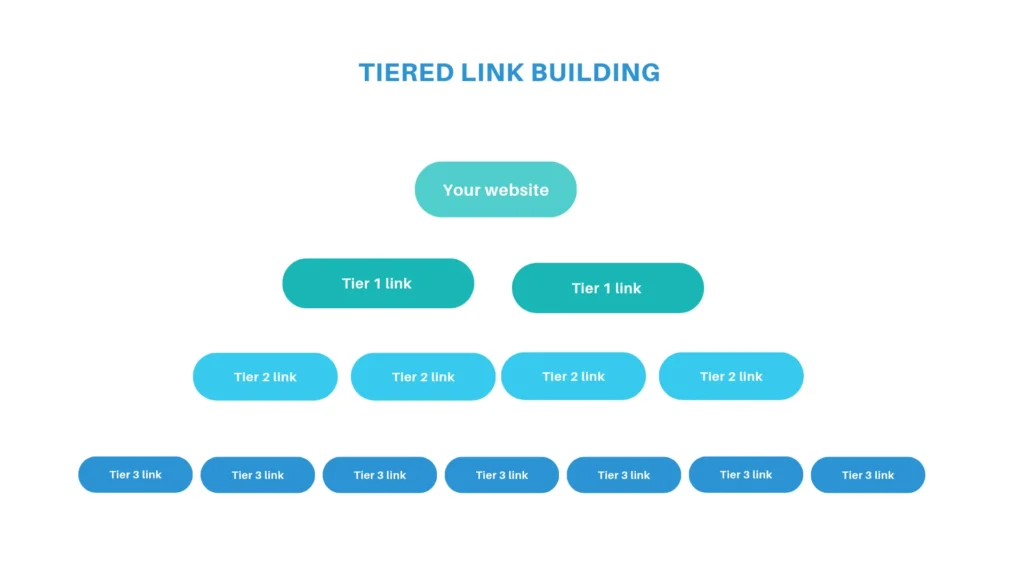
- Tier 1 links: Strong backlinks pointing directly to your blog
- Tier 2 links: Average backlinks pointing to the tier 1 links
- Tier 3 links: Below average backlinks pointing to the tier 2 links
Taking the same food and recipe website as an example, let us explain this strategy in the simplest way.
So let’s say for building quality backlinks to your website, you wrote guest blogs on a few high domain authority websites of your niche.
Now these websites have high domain authority but since you have uploaded the guest blog recently, your guest blog page which is sending backlinks to your website won’t have a high page authority.
Now you need to somehow increase the page authority of your guest post.
To do so, you build a few more backlinks from average-level websites and send those backlinks to the guest post.
Next, you build a few more low-quality backlinks and point them to the website sending backlinks to the guest post.
This way, the link authority from the tier 3 website flows to the tier 2 website, from the tier 2 website it flows to the tier 1 website, and finally, the entire authority gets passed to your website.
Benefits of using tiered link building
Now that you know what this strategy is, you must understand why you should consider using it. In other words, what are the benefits of using a tiered link building strategy?
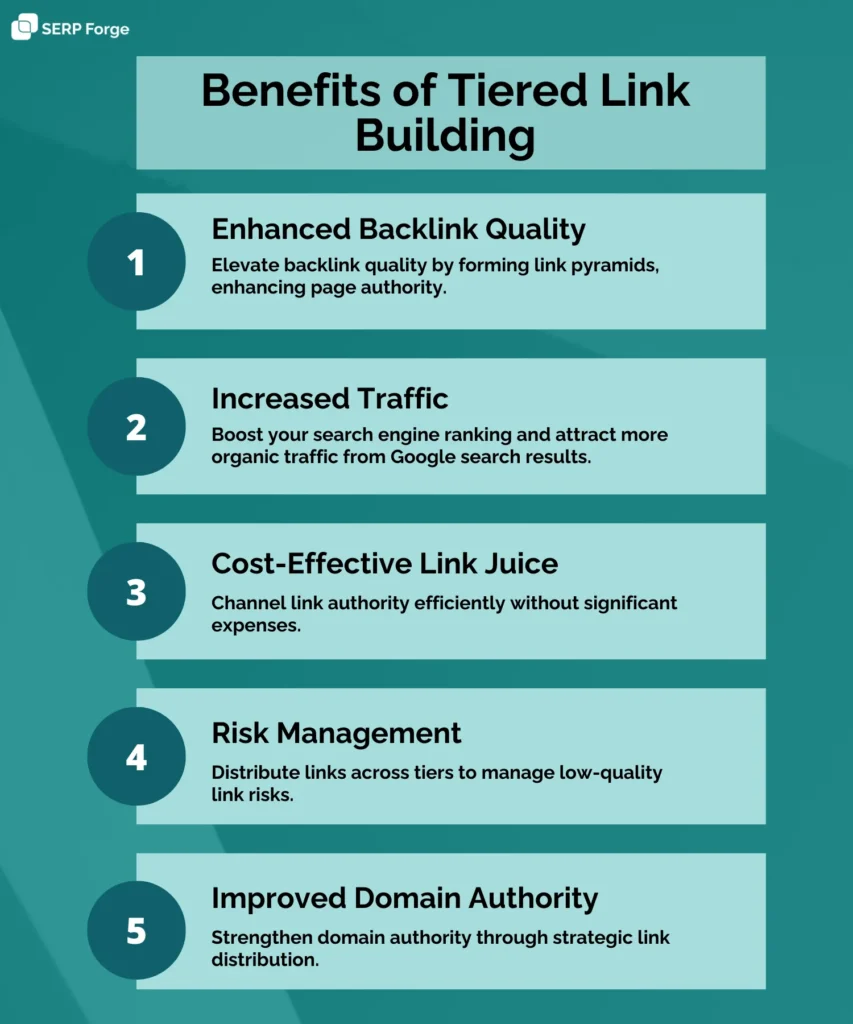
1. You can increase your backlink’s quality
The best thing about this strategy is that you have the power to increase the quality of your backlinks.
There are high chance that most of your guest posts uploaded on high-authority websites won’t receive any backlinks.
Because of this, the guest post sending backlinks to your website will have a low page authority.
With tiered link building, you can build a pyramid of links and ensure that your guest post gets links from other websites.
This way, if the page authority of your guest post increases, the quality of the backlink it sends you also increases.
Guest Posting Sites List
Ready to skyrocket your website’s ranking? Click here to access our curated list of guest posting sites.
2. You get more traffic
If you execute the strategy well, you will in the end receive the entire link authority flowing toward your website.
This will increase your ranking on search engines. And when your ranking improves on search engine results, you organically receive more traffic from Google search results.
3. Easy and cheap link juice
Getting high-quality backlinks is not a child’s play. To get them you might sometimes have to spend a few hundred or thousand dollars.
What’s more? Getting high-quality backlinks also requires a lot of time.
You must find the perfect prospects, send them an email, ask them to provide a backlink, perform various other strategies, and then you’ll get the link.
This is not the case with tiered link building.
With tier link building, you can land on 1 or 2 high-authority guest posts and then focus on building average and low-quality backlinks to your guest post, which can then easily pass the link juice to your website.
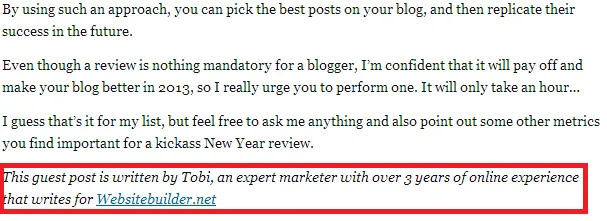
4. You can manage the risks of low-quality links
You might be in a situation where you need to build links no matter what. In such cases, going for low-quality spammy backlinks pointing directly to your website can be risky.
That’s when you can leverage tiered link building.
With tiered link building, you can distribute all levels of links with the best links pointing directly to your website.
In case Google finds out about the low-quality links, it would be difficult for it to find a connection with your website.
5. You can increase your domain authority
Another great thing about tiered link building is that it gives you the opportunity to increase your domain authority.
So when you place a link on your high domain authority website’s guest post and then focus on increasing its page authority, you get to leverage both the domain’s authority and the page authority.
This makes your guest blog page a really strong web page.
Receiving backlinks from such a strong web page increases your domain authority and therefore gives you higher rankings on Google.
Risks of tiered link building
Before you start using this strategy, you must know that tiered link building is considered a gray-hat SEO strategy by some people.
This means that there are also some risks associated with this strategy.
Let’s learn about them.
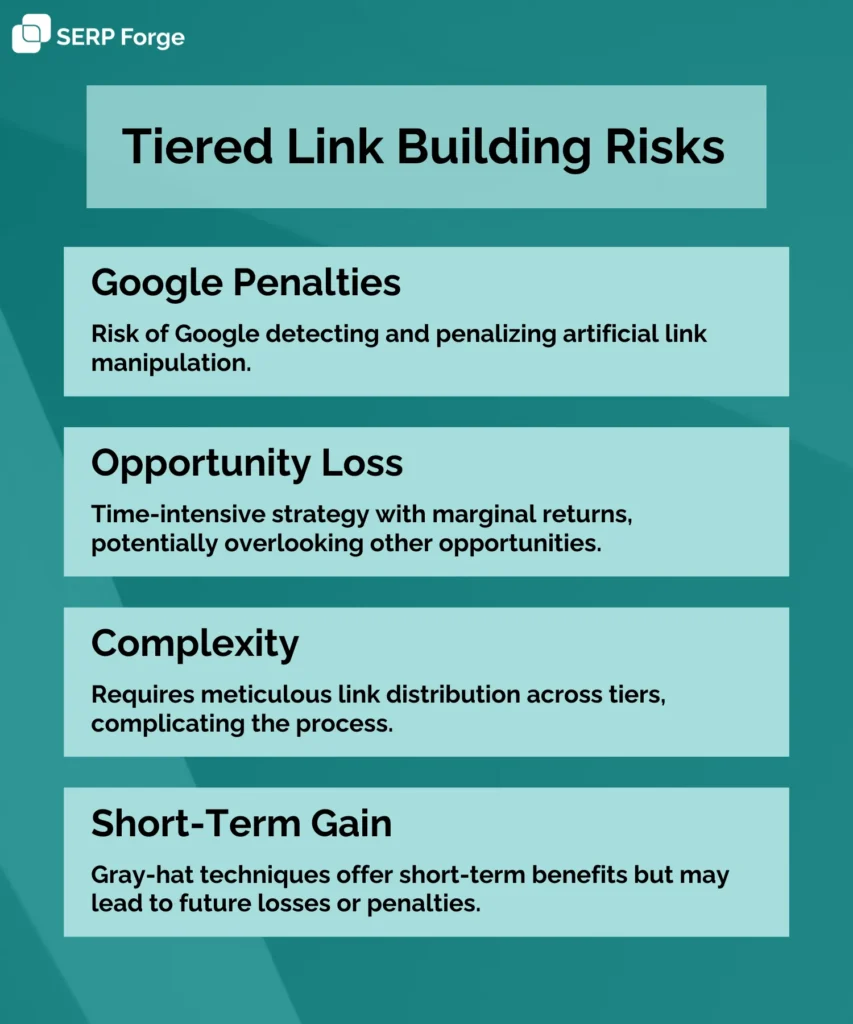
1. Penalties from Google
Google is the most advanced search engine with thousands of algorithms trying to get the best results.
You must know that Google can sometimes identify if you are using a tiered link building strategy.
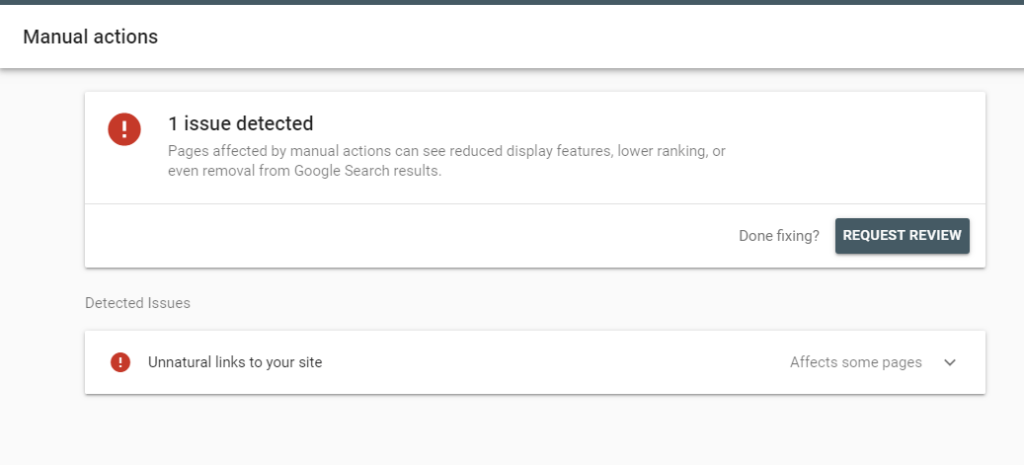
Google’s algorithms are updated each year with new advancements that can identify if you are using a tiered link building strategy.
If you perform the strategy well (in a white-hat manner), then you are safe.
But if you make any wrong move and Google finds out that you are trying to manipulate search rankings with artificial links, it can penalize your website.
2. You are missing out on other opportunities
A tiered link building strategy can sometimes be time-consuming.
What’s more? The effects of the many low-quality links that you build are also marginal.
This means that it won’t give you much return.
Considering the time you spend on building average-level and low-quality links, we can see that you will be missing out on a lot of other opportunities.
The time spent on the tiered link building strategy could’ve been used on other link building strategies that are less risky.
3. It is complicated
When using this strategy, it’ll not be just about your website. You’ll have to focus on properly distributing links accordingly.
First, you’ll have to get links from high-domain authority websites.

Then, you’ll have to get average-level links to the pages that are sending you backlinks.
Then, you’ll have to get more low-quality links to the pages that are sending backlinks to the top-level websites.
All of this can be complicated.
4. Future losses
Most of the black-hat and gray-hat SEO techniques are not meant for long-term games.
These are techniques that can benefit you only for a short period.
Either you might get penalized by Google or you might yourself stop using these techniques after a short period.
That’s why you must only consider these strategies as something that can benefit you in the short term and not go for it as a long-term strategy.
How to build tier 1, tier 2, and tier 3 links (The right way)
Now let’s learn what’s the best way to use a tiered link building strategy.
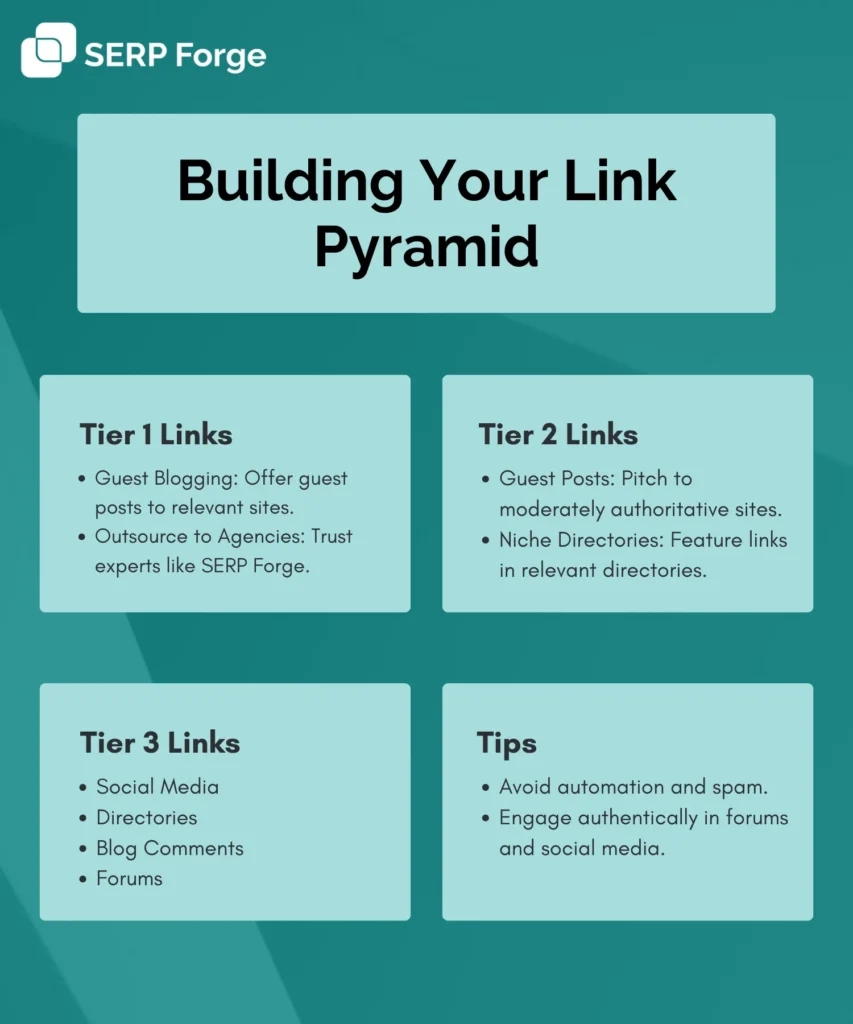
Tier 1 links (how to build)
So at the top, we have the tier 1 links. These are the high-quality dofollow links pointing to your website.
Tier 1 links come from websites with:
- High domain authority
- High traffic
- Strong backlink profile
How to get tier 1 links
Now there are many ways to find and get backlinks from these kinds of websites. However, one of the most common techniques is guest blogging.
All you have to do is identify the website that satisfies all the three requirements mentioned above, and ask them if they would like to get a guest post from you.
Most businesses, when it comes to building tier 1 links, outreach the work to blogger outreach services.
Why? You can’t play when it comes to building tier 1 links. These are the links that set the strongest foundation for your rankings.
When trying to build link yourself, there are a high chances that you may take a wrong step which can result in you losing all your opportunities.
That’s why for building such tier 1 links you must outsource your work to link building services like SERP Forge who will do everything for you right from the researching and outreaching part to setting up the links.
This way you can easily get high-quality links and set the foundation for your tier 1 links.
Tier 2 links (how to build)
Once you set your foundation with tier 1 links, you must then start building your tier 2 links.
Tier 2 links are links that are not as valuable as tier 1 links but can still provide you some benefits and are worth pursuing.
These tier 2 links don’t point directly to your website, but to the site with the tier 1 link.
While tier 1 links were all about quality over quantity, tier 2 links can lower the quality bar just a bit and focus on increasing the number of links.
What’s more? These links can contain both dofollow as well as nofollow backlinks. However, your main focus must still be on getting dofollow links.
How to get tier 2 links
Well, there are many ways to get tier 2 links. However, the most commonly used techniques are:
Guest posting on mildly authoritative websites
You can reach out to website owners of mildly authoritative websites and ask them if they would like to get a guest post from you.
On acceptance, you can write a guest post and place a link to your previous guest post (tier 1 link).
Niche-based article directories
Another way to get tier 2 links is by having your tier 1 link URL featured on the niche-based article directory.
Popular link roundups
A link roundup basically refers to when a website owner creates an article that features a collection of valuable links from around the web.
You can identify a relevant link roundup and ask the website owner to add your guest post’s URL (tier 1 link) to that roundup list.
Tier 3 links (how to build)
Now let’s move on to the tier 3 links.
Tier 3 links are low-quality links that mostly contain a nofollow tag and are more in quantity as compared to tier 1 and 2 links.
Common examples of tier 3 links include:
- Social media links
- Directory links
- Blog commenting links
- Forum links
High DA Link Sharing Websites
Want a lists of high DA link-building websites? Click here to access the full list.
How to get tier 3 links
Many people use various automation tools and spammy techniques to generate tier 3 links. However, you must try to be more careful.
You can use methods like participating in industry forums and discussions, creating a valuable social media profile, sharing content on social bookmarking sites, participating on Q&A sites, directories, and blog commenting.
When to consider tier link building
The tiered link building strategy is an old-school technique that used to rock in the past.
It still works, but with Google updating its algorithms, it has become quite difficult to play a safe game.
Let’s understand when to consider tier link building.
When it’s your only choice
Some niches are highly competitive. If you work in a niche with high competition, it’s quite difficult for you to build a strong backlink profile.
In such cases, you can go for tier link building.
This technique can help you kickstart your link building and give you a spot in the game. However, keep in mind that it can only work as a short-term strategy.
When you have organic opportunities
You can consider using this strategy when you have organic opportunities to use it.
For example, the owner of the website where you are uploading a guest post asks you to add a link to other relevant posts. In such cases, you can organically build tier 2 links.
When you need to leverage a diversity of links
See, getting high-quality tier 1 backlinks to your website is a really good thing. But what if you want to leverage other average-level and low-quality links as well?
That’s when you can use tiered link building.
With tiered link building, you will get to benefit from all kinds of backlinks while also being safe from spammy backlinks as they don’t directly point to your website.
Conclusion
So this was the complete blog about what tier link building is and how to use it.
Remember, if done right, tiered link-building can be a highly effective strategy for your website. And if you fail to perform it correctly, it can result in penalization as well.
Now it’s your turn to start executing this strategy if you’ve decided to go for it.
FAQs
What are tier 1 backlinks?
Tier 1 backlinks are high-quality Dofollow links coming from strong websites that point directly to your website in the pyramid.
Methods: Guest blogging
What are tier 2 backlinks?
Tier 2 backlinks are medium-level links coming from web 2.0 sites that point to the tier 1 links in the pyramid.
Methods: Guest posting on mildly authoritative websites, niche-based article directories, and link roundups
What are tier 3 backlinks?
Tier 3 backlinks are low-quality links coming mostly from blogs and forums that point to the tier 2 links in the pyramid.
Methods: Participating in industry forums and discussions, creating a valuable social media profile, sharing content on social bookmarking sites, participating on Q&A sites, directories, and blog commenting.


